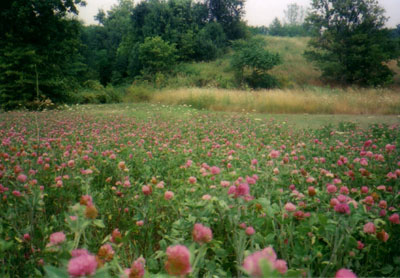Human Flower Project
Wednesday, October 18, 2006
When You’re Not, You’re Not
Can red clover help middle-aged women chill out?
 A Hot Flash in the Pan
A Hot Flash in the Pan
Charlie van Pelt
If you’re a woman considering a sex change, may we recommend getting on with it before the other “change”? You may spare yourself many sleepless nights and save enough on the a/c bill to cover the cost of surgery. We refer, of course, to hot flashes, the infernal side effect of menopause.
Those who decide to stick it out (womanhood, that is) may have considered or even tried various remedies to squelch these harrowing episodes. One controversial formula is red clover. Like soy, it contains isoflavones: “plant-based substances that are structurally similar to the hormone estrogen.” (Hot flashes occur when the body’s estrogen levels become erratic, and when you’re on deadline or about to serve dinner.)
We don’t practice medicine here, but we do sympathize with any woman who’d like to keep her composure intermittently for the next five or so years. In the spirit of free inquiry—and since you’re not sleeping anyway—here are a variety of takes on red clover. This one from the Mayo Clinic says, “clinical trials have yielded unimpressive results.” This report, based on two small studies, claims the plant extract “may give some relief.” A study published in the July 9, 2003 JAMA concludes, “Although the study provides some evidence for a biological effect of (supplements containing isoflavones), neither supplement had a clinically important effect on hot flashes or other symptoms of menopause.” Not surprisingly, the most encouraging piece was based on studies funded by a company selling red-clover-based products.
Aiyee! you’re saying.

Field of red clover
Photo: Ohio Valley Herbal Products
There’s lots more consensus about the benefits of red clover in your garden. Mark Keaton, an extension agent in Baxter County, Arkansas, writes that cover crops add organic goodies to the earth while improving “soil structure and drainage.” He especially recommends red clover, “a legume that returns nitrogen to the soil.” He claims it’s easy to grow and “provides a beautiful carpet of red flowers” if left alone in the spring.
Richard Nunnelly agrees. “I think a cover crop is a great idea. I’ve always liked red clover planted around the first of October. It will give you terrific growth this winter and make your garden look good, too. Cut it in mid-February and allow it to dry for a week or so before you turn it in and prepare your soil for your spring planting.” (Turning it under “green” can rob your soil of nitrogen.)
Having read all this, we hope you’re feeling cooler. If not, then just look at this fine red clover photo James Saunders took in Oregon and repeat after us: “This too shall pass.”




